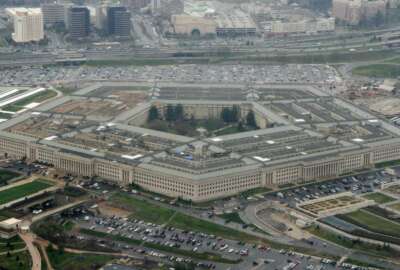
In the Arizona desert, Army got first glimpse of an AI-enabled battlefield
In the first of what's set to become an annual event, the Army applied AI and machine learning technologies to get its first real experience with hyper-connected...
The Army said it’s rapidly moving toward an era where all of its weapons systems and sensors can not only communicate with each other, but also work together to help make decisions on the battlefield.
As part of a new concept called Project Convergence, over five weeks in August and September at Yuma Proving Ground, the Army took the set of tactical networking equipment it’s already deploying to soldiers and combined it with stacks of artificial intelligence technologies, new commercial satellite capabilities, and other technologies that are designed to fuse together sensor data from multiple different “domains” – ground, air and space.
Considering it was the first go-round in what’s planned to be an annual event, officials say they were pleasantly surprised with how the exercise turned out.
Until last month, many of the Army’s ideas about AI and multi-domain operations were really just conceptual, said Doug Matty, the director of the Army Artificial Intelligence Task force.
“Project convergence gave us the window by which we could not only see, but experience the progression from data fusion to system collaboration to cross-functional synergy,” he told reporters Wednesday. “Next year, when we bring in significantly more joint partners, that’s when we’ll actually be able to achieve convergence.”
Among the technologies the Army demonstrated: TITAN, a ground-based system that brings together data from sensors on the ground, in the air and in space to generate targeting information. That information was then fed into another AI algorithm called Firestorm, which is designed to identify enemy targets and determine which weapons system or “shooter” would be most effective against it.
Matty said that doesn’t mean machines have the ability to fire weapons on their own. Consistent with DoD’s AI ethical principles, the military will have a “human in the loop” at all times. But Project Convergence did show it’s possible to reduce the time it takes to move accurate targeting data from “sensor to shooter” from 20 minutes to 20 seconds.
“And we also reduced the touch time of the individual. He or she was only brought in at that critical point where there was a human in the loop requirement,” he said. “So rather than watching the entire kill chain evolve over those minutes, that information, along with a thumbnail was provided to the operator for the common operating picture. And by merely touching the icon, a thumbnail was available for them to look at and make that verification, and then take that next step to classify it as a threat, or leave it as something to be observed as unknown.”
The Army says Project Convergence also provides a stepping stone to DoD’s larger vision of Joint All-Domain Command and Control, which aims to network systems together across each of the military services. To that end, the Air Force, Marine Corps and Navy have each agreed to participate in next year’s demonstration.
“This year, we demonstrated the ability to talk from F-35s and Ospreys to ground forces and pass ground-sensed targets to aircraft and aircraft-sensed targets to ground factors,” said Brig. Gen. Ross Coffman, the director of the Army’s Next Generation Combat Vehicle Cross Functional Team. “And what we’ve asked [the other services] to do is come back to us in the coming weeks with what sensors and what shooters they would like to integrate into this event. We don’t have an exact list today, but that’s coming in the next few weeks.”
And in 2022, the Army plans to start incorporating international partners into the demonstration.
The Army has already been deploying upgrades to its tactical network for the past several years, adding new technologies each year as part of annual “capability sets.”
Brig. Gen. Robert Collins, the program executive officer for Command, Control and Communications (Tactical), said some of the experiments the Army ran as part of this year’s Project Convergence tested the existing network architecture to its limits.
“Specifically, as you start to go from manned to unmanned platforms and unmanned to unmanned ones, there are elements within the air tier that traditionally had their own data links. Now, as we align that into our ground domain mesh network, we have to take that into consideration,” he said. “Probably one of the main things that we learned is as we extend the ground domain and bring in the air tier and move all of that sensor data across the network we need to throttle, balance and tailor that.”
Another lesson from Project Convergence: if AI and machine learning algorithms are handling much of the data analysis that has to be done by humans today, the Army can drastically reduce the amount of raw data it’s moving across its tactical network.
“We have to take an appetite suppressant on the amount we absolutely need versus what we might want on the network,” Coffman said. “You don’t need streaming video at all times. With the algorithmic solutions that are identifying enemy vehicles, those elements necessary to call for fire is really all you need. So think of a tweet, rather than a video over the network. All too often we want everything: We want the entire Swiss army knife all at once, when maybe all we need is the knife and the magnifying glass. We learned that we are capable of executing with just the required information.”
Coffman said minimizing the amount of data the Army’s transmitting also reduces the chances that an enemy could find U.S. forces by spotting their radio signatures or target those radio emissions via electronic warfare.
“We understand that there will be an EW threat to anything that’s emitting,” he said. “The first step is we have to see ourselves and fully understand when and where we’re emitting, and to what degree, and from where that can be detected. Once we’re within the range of enemy sensors, we have to be extremely disciplined on what is emitting and ensure that it’s for a specific purpose. It can’t just be emitting because that’s what it was programmed to do. We knew that going in, and we applied many of those solutions during Project Convergence.”
Copyright © 2025 Federal News Network. All rights reserved. This website is not intended for users located within the European Economic Area.
Jared Serbu is deputy editor of Federal News Network and reports on the Defense Department’s contracting, legislative, workforce and IT issues.
Follow @jserbuWFED
Related Stories





